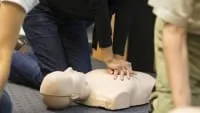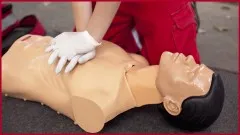
First Aid & Basic Life Support (BLS) 
This online course provides comprehensive instruction on First Aid, Basic Life Support (BLS), Automated External Defibrillator (AED) and CPR, developed by physicians and based on the most recent ILCOR Standards and Guidelines. ▼
ADVERTISEMENT
Course Feature
![]() Cost:
Cost:
Free
![]() Provider:
Provider:
Udemy
![]() Certificate:
Certificate:
No Information
![]() Language:
Language:
English
Course Overview
❗The content presented here is sourced directly from Udemy platform. For comprehensive course details, including enrollment information, simply click on the 'Go to class' link on our website.
Updated in [March 06th, 2023]
First Aid & Basic Life Support (BLS) is a comprehensive course designed to teach participants how to respond to common illnesses and injuries. It covers topics such as CPR, First Aid, AED, and BLS training. Participants will learn how to perform high-quality chest compressions, basic airway management, rescue breathing, and how to use an automated external defibrillator. This course is ideal for those who want to gain the skills and knowledge necessary to respond to medical emergencies.
By taking this course, learners will gain a better understanding of the fundamentals of First Aid and Basic Life Support. They will learn how to recognize and respond to medical emergencies, how to perform CPR, and how to use an AED. They will also learn how to assess a patient’s condition and provide appropriate medical care. Additionally, they will gain an understanding of the importance of proper medical documentation and the legal implications of providing medical care.
This course is also beneficial for those who are interested in pursuing a career in the medical field. It provides a comprehensive overview of the fundamentals of First Aid and Basic Life Support, which are essential skills for medical professionals. It also provides an introduction to the legal aspects of providing medical care, which is important for those who are considering a career in the medical field.
Overall, First Aid & Basic Life Support (BLS) is an essential course for those who want to gain the skills and knowledge necessary to respond to medical emergencies. It provides a comprehensive overview of the fundamentals of First Aid and Basic Life Support, as well as an introduction to the legal aspects of providing medical care. It is also beneficial for those who are interested in pursuing a career in the medical field.
[Applications]
After completing this course, participants should be able to apply the knowledge and skills they have learned to respond to common emergencies. They should be able to recognize the signs and symptoms of common illnesses and injuries, and be able to provide basic first aid and CPR. Additionally, they should be able to use an automated external defibrillator (AED) and be familiar with basic airway management techniques. Finally, they should be able to recognize when to call for help and when to seek medical attention.
[Career Paths]
1. Emergency Medical Technician (EMT): EMTs are responsible for providing emergency medical care to patients in need. They are trained to assess and treat a variety of medical conditions, including cardiac arrest, stroke, and trauma. EMTs are also responsible for transporting patients to medical facilities. With the increasing demand for emergency medical services, the job outlook for EMTs is expected to remain strong.
2. Paramedic: Paramedics are responsible for providing advanced life support to patients in need. They are trained to assess and treat a variety of medical conditions, including cardiac arrest, stroke, and trauma. Paramedics are also responsible for transporting patients to medical facilities. With the increasing demand for emergency medical services, the job outlook for paramedics is expected to remain strong.
3. Emergency Room Nurse: Emergency room nurses are responsible for providing care to patients in need of emergency medical services. They are trained to assess and treat a variety of medical conditions, including cardiac arrest, stroke, and trauma. Emergency room nurses are also responsible for transporting patients to medical facilities. With the increasing demand for emergency medical services, the job outlook for emergency room nurses is expected to remain strong.
4. Firefighter: Firefighters are responsible for responding to fires and other emergencies. They are trained to assess and treat a variety of medical conditions, including cardiac arrest, stroke, and trauma. Firefighters are also responsible for transporting patients to medical facilities. With the increasing demand for emergency medical services, the job outlook for firefighters is expected to remain strong.
[Education Paths]
1. Bachelor of Science in Nursing: This degree program provides students with the knowledge and skills necessary to become a registered nurse. Students will learn about anatomy, physiology, pharmacology, and medical ethics. They will also gain experience in patient care, communication, and critical thinking. This degree is becoming increasingly popular as the demand for nurses continues to grow.
2. Bachelor of Science in Emergency Medical Services: This degree program prepares students to become emergency medical technicians (EMTs). Students will learn about emergency medical care, patient assessment, and medical terminology. They will also gain experience in responding to medical emergencies, providing basic life support, and using medical equipment. This degree is becoming increasingly popular as the demand for EMTs continues to grow.
3. Master of Science in Health Administration: This degree program provides students with the knowledge and skills necessary to become a health care administrator. Students will learn about health care policy, finance, and management. They will also gain experience in managing health care organizations, developing health care strategies, and leading teams. This degree is becoming increasingly popular as the demand for health care administrators continues to grow.
4. Doctor of Nursing Practice: This degree program prepares students to become advanced practice nurses. Students will learn about advanced nursing practice, research, and leadership. They will also gain experience in providing advanced nursing care, developing health care policies, and managing health care teams. This degree is becoming increasingly popular as the demand for advanced practice nurses continues to grow.
Course Syllabus
Introduction to First Aid
Medical Problems
Injuries and Trauma
Environmental Injury and Illness
General Concepts of Basic Life Support
BLS for Adults
Use of an Automated External Defibrillator (AED)
BLS for Children (Age One to Puberty)
BLS for Infants (Age 0 to 12 Months)
Use of an AED for Children & Infants
Airway Management
Relief of Choking
BLS Skills
Study Aids
Pros & Cons

Good platform and amazing experience.

Amazing course.

Good information and ideas.

Very informative and clear presentation.

Teaches everything needed to know.

Excellent.

Asking for more money.

Repeating courses.

Skips basic treatments.

Incorrectly pronounces words.

Narrators inaudible at points.
Course Provider

Provider Udemy's Stats at AZClass
Discussion and Reviews
0.0 (Based on 0 reviews)
Explore Similar Online Courses

Transforming Your Creative Ideas into Personal Projects

Inventory Management

Python for Informatics: Exploring Information

Social Network Analysis

Introduction to Systematic Review and Meta-Analysis

The Analytics Edge

DCO042 - Python For Informatics

Causal Diagrams: Draw Your Assumptions Before Your Conclusions

Whole genome sequencing of bacterial genomes - tools and applications

First Aid and Bloodborne Pathogens (BBP)

2 How To Save A Life - Advanced

Basic Life Support (BLS)
 Related Categories
Related Categories
Quiz
 Submitted Sucessfully
Submitted Sucessfully
1. What is the purpose of this course?
2. What type of certification is available for this course?
3. What is the expected outcome of this course?
4. What is BLS?
Correct Answer: Basic Life Support


Start your review of First Aid & Basic Life Support (BLS)